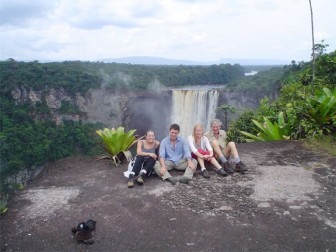Guyana still has a long road to travel in order to create a lucrative tourist industry and the key to that accom-plishment reposes in a significantly expanded inter-national marketing pro-gramme that centres around the country’s best-known attraction, the Kaieteur Falls.
Visitors to Guyana and Guyanese residing both at home and abroad can view the famous waterfall that boasts the longest sheer drop, by booking one-day excursions with tour operators or directly with local aircraft operators. Not everyone who travels to Guyana to experience Kaie-teur Falls gets their heart’s desire. Their disappointment, invariably, is a function of the vissicitudes of a tourist industry that simply lacks the infrastructure to accommo-date the demand to visit the famous natural wonder.
For tour operators who must charter planes to take sightseers to Kaieteur and for aircraft owners who some-times operate their own charters to the Falls, the profit margin is wafter thin. In fact, any return at all on a Kaieteur charter assumes that flights are fully booked. That is where, sometimes, the pro-blem arises. Tour groups are rarely if ever consistent in their numbers and when those numbers fall short of what is required to fill an aircraft the trip becomes unprofitable. In those circumstances tough decisions must be made.
Frequently, with one or two empty seats making the difference between making a modest profit or ending up out-of-pocket, tour operators are compelled to postpone Kaieteur trips for the next day or perhaps even the next week. Perhaps undertstand-ably, disappointed customers demand their money back; immediately. That too is often not possible since expenses, including aircraft charter and meals would already have been incurred. Situations like those can take their toll on the image of the service provider.

Proprietor of Wonderland Tours Alisha Ousman says she understands only too well the challenges involved in undertaking tours to Kaieteur. After various experiences of cancelled flights and disappointed, sometimes irate customers, her company has added a disclaimer to its contracts. The disclaimer is blunt and to the point. “Flights may be rescheduled in cases of aircraft unavailability, pilots, bad weather pattern and insufficient passengers.”
Roraima Airways boss Captain Gerry Gouveia says the problems associated with tours to Kaieteur are “very real.” Gouveia believes that “for one reason or another,” only about 40% of the people who want to see Kaieteur have actually seen the Falls. He explains that the problem is intricate and can sometimes go beyond simple failure to fill seats. “Operating and maintenance costs for aircraft are high and the truth is that there are not enough people making bookings to see Kaieteur Falls to justify having aircraft simply standing by to make those runs. There are other sectors of the economy which the aircraft industry serves.”
Gouveia argues that invest-ment in additional aricraft cannot be contemplated outside the framework of passenger demand. “If there are to be more aircraft there must be more passengers.”
Trips to Kaieteur with Wonderland Tours currently cost around US$195 (approxi-mately $39,000) per person. Ousman says that a local charter costs a tour operator $265,000 (approximately US$1,325). To those costs must be added charges for passes, tour guide fees, meals and ground transportation. “We use the Islander which has nine seats or the Caravan which has thirteen seats. Of course, apart from the problem of seating there are also weight restrictions on these aircraft, a circumstance that has given rise to another tour operator requirement: “Accurate body weight must be given upon payment to avoid the cancellation of flights due to overweight.”
Ousman says Wonderland Tours has had cases where after arriving at the airport, “we have sometimes had to take off a passenger. That means we lose money and it also may mean a disappointed customer.”
Gouveia crunches the numbers from an aircraft owner’s perspective. He explains that having charged US$1,286 for a charter to Kaieteur, US$700 goes to fuel; the pilot’s fees are US$40 an hour. “There are maintenance costs and insurance costs to cover as well. You do the math,” he says.
Ousman explains that tours could be postponed for any number of reasons. Empty seats apart, aircraft could suddently not become available or the weather could turn ugly. There have been occasions, she says, when investments and meals and ground transportation have been lost to cancelled flights. “It’s that kind of business and we tell our customers the evening before,” she says.
Gouveia estimates that around 5,000 bonafide tourists see Kaieteur every year. Ousman agrees, assert-ing that each year more and more people come to Guyana to visit Kaieteur. “It is possible that as many as 2,000 more people visited Kaieteur last year than the previous year,” she says. Still, they both say that the demand to see the falls remains high.
Gouveia believes that the problems that aircraft owners and tour operators face in meeting visitor demand for trips to Kaieteur will remain, unless the long-overdue acceleration of the marketing of Guyana as a tourist des-tination begins. He reminds of an interview which he gave to this newspaper some time ago in which he assserted that adequately marketing Guyana and its tourism product overseas could cost as much as US$4 million annually. At that time he said that while on the face of it, the amount may seem quite high, considera-tion should be given to the returns from such an investment. He believes that such an investment is justified when one considers the likely spin-off in terms of visitor arrivals, the expansion of the aviation sector to accommo-date more visitors to Kaieteur and other places of interest in Guyana and to grow the tourism industry generally.









